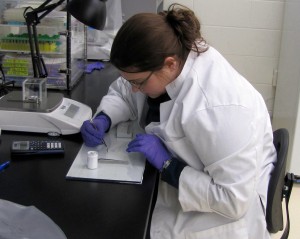Scientist uses stable isotopes to track eating patterns for biomedical research
November 20, 2012

907-474-5221
11/20/12
Diane O’Brien, a nutritional ecologist, thought it was a no-brainer to use stable isotope signatures to discover what people are eating.
She used these naturally occurring markers frequently to study the diets of butterflies and other bugs. Stable isotopes as food markers are a commonly used tool for ecologists—those who study living things and their relationship with each other and the environment.
But when she presented the idea that stable isotopes could be helpful in Alaska Native health studies to a panel of biomedical advisors during the early days of the Center of Alaska Native Health Research, she was met with resistance.
‚ÄúThey were skeptical,‚Äù said O‚ÄôBrien, a CANHR researcher and associate professor of biology and wildlife at –‘”˚…Á.
So O’Brien set out to prove that, indeed, stable isotopes could show what people were eating. Her project, called “Developing a Novel Set of Diet Pattern Biomarkers Based on Stable Isotope Ratios,” began in 2006 and was funded by the National Institutes of Health. She, along with others in her laboratory, identified nitrogen and carbon stable isotope ratios as two markers in subsistence and market foods by working with Yupiit who live in Alaska’s Yukon Kuskokwim delta.
“Our bodies are made up of different elements, mostly oxygen, carbon, hydrogen, nitrogen, calcium and phosphorus,” O’Brien explained. “Stable isotopes are atoms of a single element with a slightly different mass, often referred to as ‘heavy’ and ‘light.’” She further explained that these naturally occurring isotopic differences were harmless and not radioactive.
The ratio of those naturally occurring heavy and light stable isotopes varies in the foods people eat, she said. Certain foods are particularly distinct..
“Atoms from our food become part of our bodies, including both heavy and light isotopes,” she said. “Those distinct stable isotope ratios are what we thought would show us what people eat.”
Currently, scientists ask people what and how much they ate over a time period, said Andrea Bersamin, the director of CANHR’s Nutrition and Physical Activity Core.
The tool, called a food recall, can provide researchers with a lot of information about food and its relationship to health, but it’s time consuming, expensive and tedious. It’s not completely accurate either, as it depends on people’s memories and their willingness to admit to everything they ate for a midnight snack, Bersamin noted.
O’Brien’s challenge then was to show that measuring stable isotopes could provide dietary information that was reliable and useful to health research. To begin O’Brien and her team analyzed 280 subsistence and market foods, which Bersamin had identified as important to Yupiit, for their stable isotope signatures.
O’Brien found that the nitrogen isotope ratio was very high in marine foods, such as fish and seals, while the carbon isotope ratio was high in market foods because of corn. Corn is used as a sweetener in sugary drinks, feed for livestock and has a particularly high carbon isotope ratio.
She then tested blood and hair samples of 68 Yupiit living in Southwestern Alaska for these and other stable isotope markers. She and her team compared the findings with information from four food recalls given to the 68 participants to see how well they captured actual diets.
‚ÄúWe were able to confirm our suspicions that stable isotopes were great dietary markers of fish and corn-based sweeteners,‚Äù said Sarah Nash, a –‘”˚…Á Ph.D. candidate who works with O‚ÄôBrien.
The team then used the stable isotope ratios to study how diet varies in the Yupiit.
“We confirmed that intake of traditional foods increased with age, and intake of market foods decreased with age,” she said, “the stable isotopes show this pattern very strongly”.
Those Yupiit who said they were traditional Yup’ik also had high nitrogen stable isotope ratios, Nash said.
In this way, stable isotopes can be an indicator of cultural practice, O’Brien said. In her previous life as a bug scientist, diets tended to be simple. Not so with human diets, which are complicated by food availability, preference and social practice.
“There is a strong cultural relationship to food,” O’Brien said. “When you’re measuring stable isotopes, you are measuring cultural practices.”
CANHR’s scientists are eager to use O’Brien’s stable isotopes, given the known health benefits of eating fish.
“Diane’s findings offer many possibilities,” Bersamin said. “Using natural stable isotopes as food markers could save a lot of time and money as they are an accurate measure of fish consumption.”
ON THE WEB:
Definitions:
Stable isotopes: Stable isotopes are atoms of a single element with a slightly different mass, often referred to as ‘heavy’ and ‘light.’” The slight differences are due to the number of neutrons in the atom’s nuclei. They are termed stable because they do not decay spontaneously.
Unstable isotopes: Unstable isotopes are atoms of a single element with slightly different mass but are deemed unstable because they either have too many or too few neutrons in their atom’s nuclei. They are radioactive and decay.
Isotope ratio: The balance of the heavy and light stable isotopes. This balance is used as a measurement.
Food Recall: A certified interviewer asks a participant about the kind of food and how much he/she has eaten over a 24-hour period. The information can be used in nutritional studies or to help the participant understand what nutrients may be lacking in his/her diet.
Yupiit: The plural of Yup’ik.


